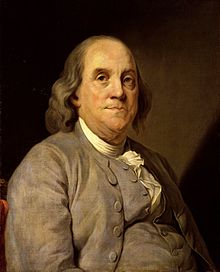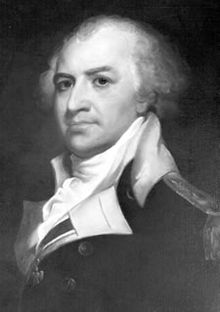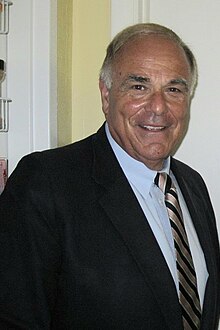This is an old revision of this page, as edited by Golbez (talk | contribs) at 02:06, 8 May 2008 (→References). The present address (URL) is a permanent link to this revision, which may differ significantly from the current revision.
Revision as of 02:06, 8 May 2008 by Golbez (talk | contribs) (→References)(diff) ← Previous revision | Latest revision (diff) | Newer revision → (diff)| Party | Governors |
|---|---|
| Republican | 25 |
| Democratic | 12 |
| Democratic-Republican | 6 |
| Whig | 2 |
| None | 1 |
| Anti-Masonic | 1 |
The following is a list of the Governors of the Commonwealth of Pennsylvania. The governor is the head of the executive branch of Pennsylvania's government and the commander-in-chief of the state's military forces. The governor has a duty to enforce state laws, and the power to approve or veto bills passed by the Pennsylvania Legislature and to convene the legislature. The governor may grant pardons except in cases of impeachment, but only when recommended by the Board of Pardons.
The first constitution in 1776 created the Supreme Executive Council as the executive branch, with the President as its head. The president was chosen annually by the council, though with no specific term dates. The 1790 constitution abolished the council and replaced the president with a governor, and established a three-year term for governor commencing on the third Tuesday of the December following the election, with governors not allowed to serve more than nine out of any twelve years. The 1838 constitution moved the start of the term to the third Tuesday of the January following the election, and allowed governors to only serve six out of any nine years. The 1874 constitution lengthened the term to four years, and prohibited governors from succeeding themselves. The current constitution of 1968 changed this to allow governors to serve two consecutive terms.
If the office of governor becomes vacant through death, resignation, or conviction on impeachment, the lieutenant governor becomes governor for the remainder of the term; if the office is only temporarily vacant due to disability of the governor, the lieutenant governor only acts out the duties of governor. Should both offices be vacant, the president pro tempore of the state senate becomes governor. The position of lieutenant governor was created in the 1874 constitution; prior to then, the speaker of the senate would act as governor in cases of vacancy. Originally, the lieutenant governor could only act as governor; it was not until the 1968 constitution that the lieutenant governor could actually become governor in that fashion. Governors and lieutenant governors are elected on the same ticket. The original 1776 constitution created the position of "vice-president", though no provision was made if the office of president became vacant, which occurred four times. Contemporary sources continue to label the chief executive in such times as the vice president, without any notion of succeeding to the presidency. One acting president, George Bryan, has since been recognized as a full-fledged governor, due to his acting as president for over six months. The office of governor has been vacant for an extended period once, a 17-day gap in 1848 between the death of the previous governor and the swearing in of his acting successor.
There have been seven presidents and 45 governors of Pennsylvania, with two governors serving non-consecutive terms, totalling 54 terms in both offices. The longest term was that of the first governor, Thomas Mifflin, who served three full terms as governor in addition to two years as president. The shortest term belonged to John C. Bell, Jr., who served only 19 days as acting governor after his predecessor resigned. The current governor is Ed Rendell, whose second term began on January 16 2007.
Governors







Pennsylvania was one of the original thirteen colonies, and was admitted as a state on December 12 1787. Prior to declaring its independence, Pennsylvania was a colony of the Kingdom of Great Britain; see the list colonial governors for the pre-statehood period.
Presidents of the Supreme Executive Council
Presidents were elected by members of the Supreme Executive Council, and predated established political parties in the United States.
| # | President | Took office | Left office | Vice President |
|---|---|---|---|---|
| 1 | Thomas Wharton Jr. | March 5 1777 | May 23 1778 | George Bryan |
| 2 | George Bryan | May 23 1778 | December 1 1778 | acting as president |
| 3 | Joseph Reed | December 1 1778 | November 15 1781 | George Bryan |
| Matthew Smith | ||||
| William Moore | ||||
| 4 | William Moore | November 15 1781 | November 7 1782 | James Potter |
| 5 | John Dickinson | November 7 1782 | October 18 1785 | James Ewing |
| James Irvine | ||||
| Charles Biddle | ||||
| 6 | Benjamin Franklin | October 18 1785 | November 5 1788 | Charles Biddle |
| Peter Muhlenberg | ||||
| David Redick | ||||
| 7 | Thomas Mifflin | November 5 1788 | December 21 1790 | George Ross |
Governors
Democratic-Republican Anti-Masonic Democratic Whig Republican
Notes
- Table only includes governors; presidents were non-partisan. 45 people have served as governor, two twice; the table includes these non-consecutive terms as well.
- Died in office.
- As Vice President of the Supreme Executive Council, acted as president. Four vice presidents acted as president at various times; however, Bryan's lengthy term has caused his term to since be recognized as being equivalent to president. Contemporary sources listed him only as vice president, acting out the duties of president.
- ^ Resigned; no reason was recorded by the Supreme Executive Council.
- The office of lieutenant governor was not created until the 1873 Constitution, first being filled in 1875.
- The fractional terms of some governors are not to be understood absolutely literally; rather, they are meant to show single terms during which multiple governors served, due to resignations, deaths and the like.
- The Federalist Party nominated Mifflin, but he himself carried no party label.
- Mifflin was elected governor three times under the 1790 Constitution, having previously been elected once as President of the Supreme Executive Council.
- Ritner was the last to serve before the 1838 constitution limited governors to serving six years out of any nine years; that constitution also changed the term to commence the next January from the election, extending Ritner's term by a month.
- First governor to serve under the 1838 constitution.
- Resigned due to illness; he died of tuberculosis only 11 days later.
- Following Francis R. Shunk's resignation, an interregnum of 17 days occurred before the speaker of the state senate, William F. Johnston, was sworn in.
- As speaker of the state senate, filled unexpired term; was later elected governor in his own right.
- First governor under the 1874 constitution, which prevented governors from succeeding themselves and lengthened terms to four years. Since Hartranft was originally elected under the previous constitution, he was allowed to succeed himself. Hartranft's first term was shortened from three to two years to fit the electoral schedule of the new constitution.
- Resigned to take an elected seat in the United States Senate.
- While official sources state Martin resigned on January 3, most contemporary sources reported his resignation as occurring on January 2.
- As lieutenant governor, acted as governor for unexpired term.
- First governor under the 1968 constitution, and thus eligible to succeed himself.
- On June 14 1993, Casey transferred executive authority to Lieutenant Governor Singel, and later that day underwent a heart-liver transplant operation. Singel acted as governor until Casey resumed the powers and duties of the office six months later on December 13 1993. Because Casey never officially resigned, Singel was only an acting governor.
- Resigned to be Director of the Office of Homeland Security.
- Since September 13 2001, Ridge had been aiding in national homeland security efforts following the September 11, 2001 attacks, temporarily transferring his powers to Lieutenant Governor Schweiker.
- As lieutenant governor, filled unexpired term.
- Governor Rendell's second term expires on January 18 2011; he is term limited.
Other high offices held
This is a table of other governorships, congressional and other federal offices, and ranking diplomatic positions in foreign countries held by Pennsylvania governors. All representatives and senators mentioned represented Pennsylvania except where noted. * denotes those offices which the governor resigned to take. † denotes those offices from which the governor resigned to take the governorship.
Living former governors
As of April 2008, five former governors were alive, the oldest being William Scranton (1963–1967, born 1917). The most recent death of a former governor was that of Raymond P. Shafer (1967–1971), on December 12 2006. The most recently-serving governor to die was Robert P. Casey (1987–1995), on May 30 2000.
| Name | Gubernatorial term | Date of birth |
|---|---|---|
| George M. Leader | 1955–1959 | January 17 1918 |
| William Scranton | 1963–1967 | July 19 1917 |
| Dick Thornburgh | 1979–1987 | July 16 1932 |
| Tom Ridge | 1995–2001 | August 27 1945 |
| Mark S. Schweiker | 2001–2003 | January 31 1953 |
References
- General
- "Governors of Pennsylvania". Pennsylvania Historical and Museum Commission. Retrieved 2008-04-18.
- "Governors Database: Pennsylvania". National Governors Association. National Governors Association. 2008. Retrieved 2008-04-01.
- Constitutions
- "Constitution of the Commonwealth of Pennsylvania". Commonwealth of Pennsylvania. 1968. Retrieved 2008-04-21.
- "Constitution of the Commonwealth of Pennsylvania" (PDF). Constitution Party of Pennsylvania. 1874. Retrieved 2008-04-21.
- "Constitution of the Commonwealth of Pennsylvania" (PDF). Constitution Party of Pennsylvania. 1838. Retrieved 2008-04-21.
- "Constitution of the Commonwealth of Pennsylvania". California University of Pennsylvania. 1790. Retrieved 2008-04-21.
- "Constitution of the Commonwealth of Pennsylvania". Avalon Project. Yale Law School. 1776. Retrieved 2008-04-21.
- Specific
- PA Const. art. IV.
- PA Const. art. IV, § 9, cl. a.
- 1776 Const. § 3.
- 1776 Const. § 19.
- 1790 Const. art. II, § 1.
- 1790 Const. art. IV, § 3.
- 1838 Const. art. II, § 3.
- 1874 Const. art. IV, § 3.
- PA Const. art. IV, § 3.
- "Executive Branch of the Several States". Retrieved 2008-04-30.
- "Prior Governors of Pennsylvania". Pennsylvania Historical and Museum Commission. Retrieved 2008-04-29.
- "MARTIN QUITS TODAY AS PENNA. GOVERNOR; BELL TO TAKE OVER". Gettysburg Times. Gettysburg, Pennsylvania. January 2 1947. Retrieved 2008-04-30.
{{cite news}}: Check date values in:|date=(help) - Stevens, Sylvester Kirby (1964). Pennsylvania - Birthplace of a Nation. pp. p. 375.
{{cite book}}:|pages=has extra text (help) - "Governors Database: Pennsylvania". National Governors Association. National Governors Association. 2008. Retrieved 2008-04-30.
- "Joseph Reed". University of Pennsylvania Archives and Records Center. Retrieved 2008-04-29.
- "Governor Simon Snyder". Pennsylvania Historical and Museum Commission. Retrieved 2008-04-29.
- Wagenseller, George Washington (1919). Snyder County Annals Volume 1. Middleburgh, Pennsylvania: The Middleburgh Post. pp. p. 8.
{{cite book}}:|pages=has extra text (help) - "HIESTER, Joseph". Biographical Directory of the United States Congress. Retrieved 2008-04-30.
- "WOLF, George". Biographical Directory of the United States Congress. Retrieved 2008-04-30.
- "STONE, William Alexis". Biographical Directory of the United States Congress. Retrieved 2008-04-30.
- "TENER, John Kinley". Biographical Directory of the United States Congress. Retrieved 2008-04-30.